Study on Crack Development and Micro-Pore Mechanism of Expansive Soil Improved by Coal Gangue under Drying–Wetting Cycles
Abstract
:1. Introduction
2. Materials and Methods
2.1. Expansive Soil
2.2. Coal Gangue
2.3. Sample Preparation
2.4. Testing Methods
2.4.1. Drying–Wetting Cycles Test
2.4.2. Crack Development Test
2.4.3. Micro-Characteristic Test
3. Results and Analysis
3.1. Crack Development Process of Expansive Soil
3.1.1. Crack Area Ratio
3.1.2. Total Crack Length
3.1.3. Average Width of Crack
3.2. Roughness of Crack Surface Analysis
3.3. Micro-Pore Characteristic Analysis
3.3.1. Porosity and Average Pore Size
3.3.2. Pore Distribution Characteristics Analysis
3.4. Micro-Pore Mechanism of Expansive Soil Improved by Coal Gangue
4. Discussion
5. Conclusions
Author Contributions
Funding
Institutional Review Board Statement
Informed Consent Statement
Data Availability Statement
Conflicts of Interest
References
- Taha, M.M.M.; Feng, C.-P.; Ahmed, S.H.S. Modification of Mechanical Properties of Expansive Soil from North China by Using Rice Husk Ash. Materials 2021, 14, 2789. [Google Scholar] [CrossRef] [PubMed]
- Wang, H.; Zhang, K.X.; Gan, L.; Liu, J.Q.; Mei, G.X. Expansive soil-biochar-root-water-bacteria interaction: Investigation on crack development, water management and plant growth in green infrastructure. Int. J. Damage Mech. 2021, 30, 595–617. [Google Scholar] [CrossRef]
- Chenarboni, H.A.; Lajevardi, S.H.; MolaAbasi, H.; Zeighami, E. The effect of zeolite and cement stabilization on the mechanical behavior of expansive soils. Constr. Build. Mater. 2021, 272, 121630. [Google Scholar] [CrossRef]
- Al-Taie, A.; Disfani, M.; Evans, R.; Arulrajah, A. Effect of Swell-Shrink Cycles on Volumetric Behavior of Compacted Expansive Clay Stabilized Using Lime. Int. J. Geomech. 2020, 20, 04020212. [Google Scholar] [CrossRef]
- He, L.P.; Yu, J.Y.; Hu, Q.J.; Cai, Q.J.; Qu, M.F.; He, T.J. Study on crack propagation and shear behavior of weak muddy intercalations submitted to wetting-drying cycles. Bull. Eng. Geol. Environ. 2020, 79, 4873–4889. [Google Scholar] [CrossRef]
- Zhu, R.; Huang, Y.H.; Zhang, C.; Guo, W.L.; Chen, H. Laboratory and centrifugal model tests on failure mechanism of canal slopes under cyclic action of wetting-drying. Eur. J. Environ. Civ. Eng. 2020, 24, 1773321. [Google Scholar] [CrossRef]
- Lu, Y.; Liu, S.H.; Weng, L.P.; Wang, L.J.; Li, Z.; Xu, L. Fractal analysis of cracking in a clayey soil under freeze-thaw cycles. Eng. Geol. 2016, 208, 93–99. [Google Scholar] [CrossRef]
- Liu, C.; Tang, C.S.; Shi, B.; Suo, W.B. Automatic quantification of crack patterns by image processing. Comput. Geosci. 2013, 57, 77–80. [Google Scholar] [CrossRef]
- Cardoso, R.; Arbabzadeh, E.; de Lima, J.T.; Flores-Colen, I.; Pereira, M.F.C.; Silva, M.C.E.; Duarte, S.O.D.; Monteiro, G.A. The influence of stone joints width and roughness on the efficiency of biocementation sealing. Constr. Build. Mater. 2021, 283, 122743. [Google Scholar] [CrossRef]
- Fu, B.Y.; Fu, L.Y.; Han, T.C.; Cao, C.H. Roughness Effects of Crack Surfaces on the Elastic Moduli of Cracked Rocks. Front. Earth. Sci. 2021, 9, 626903. [Google Scholar] [CrossRef]
- Zeng, F.; Dong, C.M.; Lin, C.Y.; Wu, Y.Q.; Tian, S.S.; Zhang, X.G.; Lin, J.L. Analyzing the effects of multi-scale pore systems on reservoir Properties-A case study on Xihu Depression, East China Sea Shelf Basin, China. J. Petrol. Sci. Eng. 2021, 203, 108609. [Google Scholar] [CrossRef]
- Kuhn, V.D.; Lopes, B.D.F.L.; Caicedo, B.; Cordao-Neto, M.P. Micro-structural and volumetric behaviour of bimodal artificial soils with aggregates. Eng. Geol. 2021, 288, 106139. [Google Scholar] [CrossRef]
- Yang, C.D.; Liu, J.J.; Lu, S.G. Pyrolysis temperature affects pore characteristics of rice straw and canola stalk biochars and biochar-amended soils. Geoderma 2021, 397, 115097. [Google Scholar] [CrossRef]
- Zhang, M.; Duan, C.C.; Li, G.F.; Fu, X.H.; Zhong, Q.; Liu, H.H.; Dong, Z.Y. Determinations of the multifractal characteristics of the pore structures of low-, middle-, and high-rank coal using high-pressure mercury injection. J. Pet. Sci. Eng. 2021, 203, 108656. [Google Scholar] [CrossRef]
- Meng, F.D.; Zhai, Y.; Li, Y.B.; Zhao, R.F.; Li, Y.; Gao, H. Research on the effect of pore characteristics on the compressive properties of sandstone after freezing and thawing. Eng. Geol. 2021, 286, 106088. [Google Scholar] [CrossRef]
- Dang, L.C.; Fatahi, B.; Khabbaz, H. Behaviour of Expansive Soils Stabilized with Hydrated Lime and Bagasse Fibre. Procedia Eng. 2016, 143, 658–665. [Google Scholar] [CrossRef] [Green Version]
- Sivakumar, N.; Mandal, A.; Karumanchi, S.R.; Singh, D.K. Effect of fly ash layer addition on the bearing capacity of expansive soil. Emerg. Mater. Res. 2020, 9, 1088–1102. [Google Scholar] [CrossRef]
- Shahsavani, S.; Vakili, A.H.; Mokhberi, M. Effects of freeze-thaw cycles on the characteristics of the expansive soils treated by nanosilica and Electric Arc Furnace (EAF) slag. Cold. Reg. Sci. Technol. 2021, 182, 103216. [Google Scholar] [CrossRef]
- Tiwari, N.; Satyam, N.; Sharma, M. Micro-mechanical performance evaluation of expansive soil biotreated with indigenous bacteria using MICP method. Sci. Rep. 2021, 11, 10324. [Google Scholar] [CrossRef]
- Wu, Y.K.; Qiao, X.L.; Yu, X.B.; Yu, J.L.; Deng, Y.F. Study on Properties of Expansive Soil Improved by Steel Slag Powder and Cement under Freeze-Thaw Cycles. KSCE J. Civ. Eng. 2021, 25, 417–428. [Google Scholar] [CrossRef]
- Wu, Y.K.; Shi, K.J.; Han, Y.; Han, T.; Yu, J.L.; Li, D.D. Experimental Study on Strength Characteristics of Expansive Soil Improved by Steel Slag Powder and Cement Under Dry-Wet Cycles. IJST-Trans. Civ. Eng. 2021, 45, 941–952. [Google Scholar] [CrossRef]
- Li, D.D.; Zhang, S.W.; Yi, H. The Influences of Sand Content and Particle Size on the Desiccation Cracks of Compacted Expansive Soil. Adv. Mater. Sci. Eng. 2021, 2021, 7752352. [Google Scholar] [CrossRef]
- Zhang, Y.G.; Zhang, W.J.; Shi, X.J.; Guo, T.; Chen, Z.H. Experimental study on unconfined compressive strength of expansive soil improved by lignin and cement. E3S Web Conf. 2021, 236, 02010. [Google Scholar] [CrossRef]
- Chu, C.F.; Zhan, M.H.; Feng, Q.; Li, D.; Xu, L.; Zha, F.S.; Deng, Y.F.; Akbar, H. Effect of Drying–Wetting Cycles on Engineering Properties of Expansive Soils Modified by Industrial Wastes. Adv. Mater. Sci. Eng. 2020, 2020, 5602123. [Google Scholar] [CrossRef]
- Kumar, K.S.R.; Thyagaraj, T. Comparison of lime treatment techniques for deep stabilization of expansive soils. Int. J. Geotech. Eng. 2021, 15, 1021–1039. [Google Scholar] [CrossRef]
- Farzaneh, A.; Share, I.H.; Amin, A. The effect of hollow polyester fiber additive on expansive clay soil. J. Phys. Conf. Ser. 2021, 1973, 012202. [Google Scholar] [CrossRef]
- Ma, H.; Zhu, H.; Yi, C.; Fan, J.; Chen, H.; Xu, X.; Wang, T. Preparation and reaction mechanism characterization of alkali-activated coal gangue-slag materials. Materials 2019, 12, 2250. [Google Scholar] [CrossRef] [Green Version]
- Wang, Z.C.; Wang, Z.C.; Zhao, W.T. Microscopic Pore and Filling Performance of Coal Gangue Cementitious Paste. J. Wuhan Univ. Technol. 2018, 33, 427–430. [Google Scholar] [CrossRef]
- Liu, S.F.; Ma, P.; Meng, F.F.; Dintwe, T.K.M.; Mao, P.; Moses, D. Strain softening and brittleness characteristics of gangue-containing coal samples. Geomech. Geophys. Geo-Energ. Geo-Resour. 2021, 7, 28. [Google Scholar] [CrossRef]
- Zhang, Y.; Baaj, H.; Zhao, R. Evaluation for the Leaching of Cr from Coal Gangue Using Expansive Soils. Processes 2019, 7, 478. [Google Scholar] [CrossRef] [Green Version]
- Li, F.; Li, X.J.; Hou, L.; Shao, A.R. A long-term study on the soil reconstruction process of reclaimed land by coal gangue filling. Catena 2020, 195, 104874. [Google Scholar] [CrossRef]
- Long, G.C.; Li, L.H.; Li, W.G.; Ma, K.L.; Dong, W.K.; Bai, C.N.; Zhou, J.L. Enhanced mechanical properties and durability of coal gangue reinforced cement-soil mixture for foundation treatments. J. Clean. Prod. 2019, 231, 468–482. [Google Scholar] [CrossRef]
- Zhou, B.B.; Shao, M.A.; Wen, M.X.; Wang, Q.J.; Robert, H. Effects of Coal Gangue Content on Water Movement and Solute Transport in a China Loess Plateau Soil. CLEAN-Soil Air Water 2010, 38, 1031–1038. [Google Scholar] [CrossRef]
- Ministry of Transport of the People’s Republic of China. Test Methods of Soils for Highway Engineering (JTG 3430-2020); China Communication Publishing & Media Management Co., Ltd.: Beijing, China, 2020.
- ISO/DIS 20290-2. Aggregates for Concrete-Test Methods for Mechanical and Physical Properties; International Organization for Standardization: Geneva, Switzerland, 2019. [Google Scholar]
- Niu, L.S.; Zhang, A.J.; Zhao, J.M.; Ren, W.Y.; Wang, Y.G.; Liang, Z.C. Study on Soil-Water Characteristics of Expansive Soil under the Dry-Wet Cycle and Freeze-Thaw Cycle considering Volumetric Strain. Adv. Civ. Eng. 2021, 2021, 6622370. [Google Scholar] [CrossRef]
- Washburn, E.W. Note on a method of determining the distribution of pore sizes in a porous material. Proc. Natl. Acad. Sci. USA 1921, 4, 115–116. [Google Scholar] [CrossRef] [Green Version]
- Gu, Z.Y.; Goulet, R.; Levitz, P.; Ihiawakrim, D.; Ersen, O.; Bazant, M.Z. Mercury cyclic porosimetry: Measuring pore-size distributions corrected for both pore-space accessivity and contact-angle hysteresis. J. Colloid Interface Sci. 2021, 599, 255–261. [Google Scholar] [CrossRef]
- Wang, X.L.; Pan, J.N.; Wang, K.; Ge, T.Y.; Wei, J.; Wu, W. Characterizing the shape, size, and distribution heterogeneity of pore-cracks in high rank coal based on X-ray CT image analysis and mercury intrusion porosimetry. Fuel 2020, 282, 118754. [Google Scholar] [CrossRef]
- Yang, J.; Huang, J.X.; He, X.Y.; Su, Y.; Tan, H.B.; Chen, W.; Wang, X.J.; Strnadel, B. Segmented fractal pore structure covering nano- and micro-ranges in cementing composites produced with GGBS. Constr. Build. Mater. 2019, 225, 1170–1182. [Google Scholar] [CrossRef]
- Rong, F.; Liu, A.T.; Chen, L.S. Dry-wet Cycle Test Study of Size Effect on Surface Cracks and Shear Strength of Expansive Soil. Int. Core J. Eng. 2020, 6, 64–73. [Google Scholar] [CrossRef]
- Zhao, G.T.; Han, Z.; Zou, W.L.; Wang, X.Q. Evolution of mechanical behaviours of an expansive soil during drying–wetting, freeze-thaw, and drying–wetting-freeze-thaw cycles. Bull. Eng. Geol. Environ. 2021, 80, 8109–8121. [Google Scholar] [CrossRef]

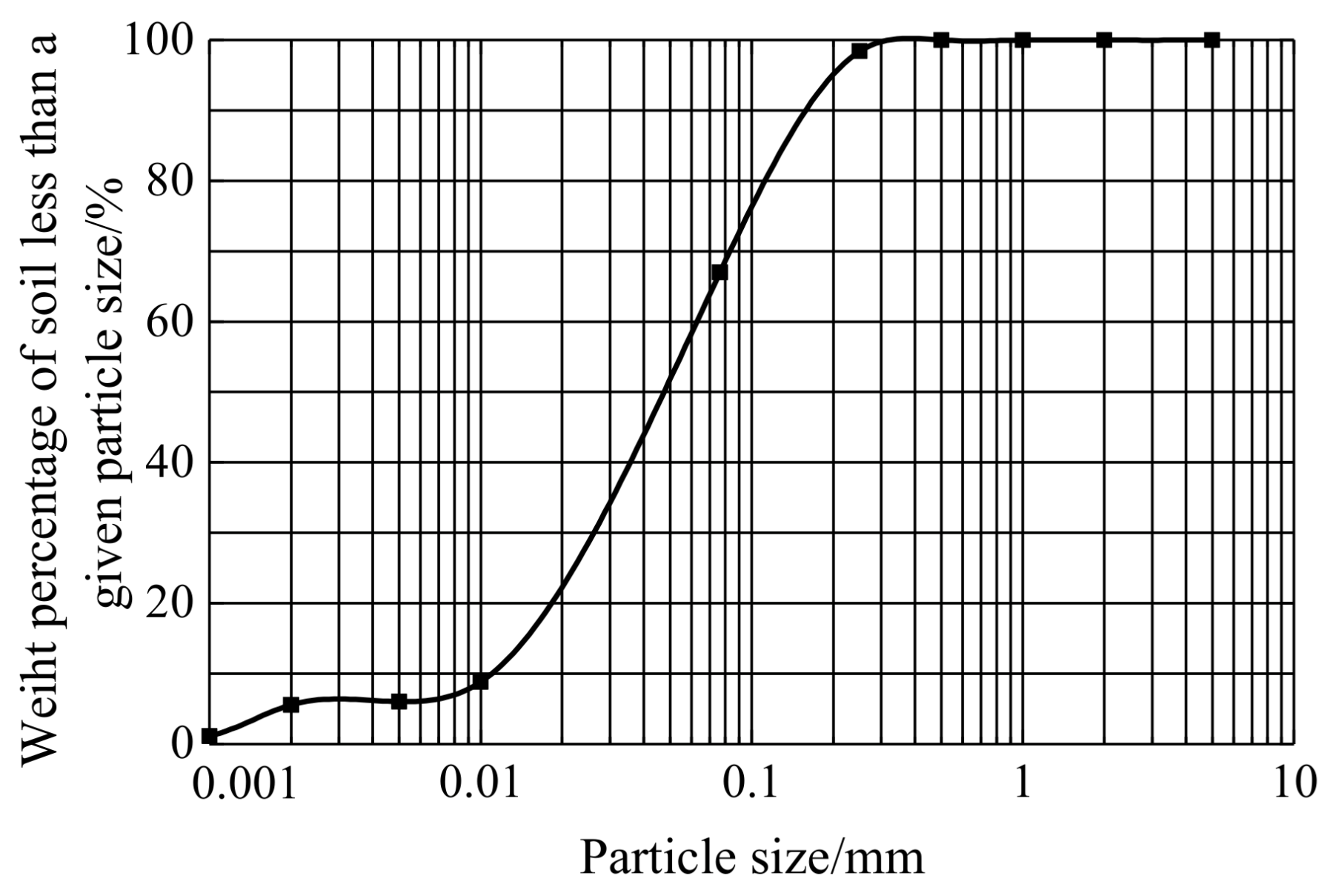


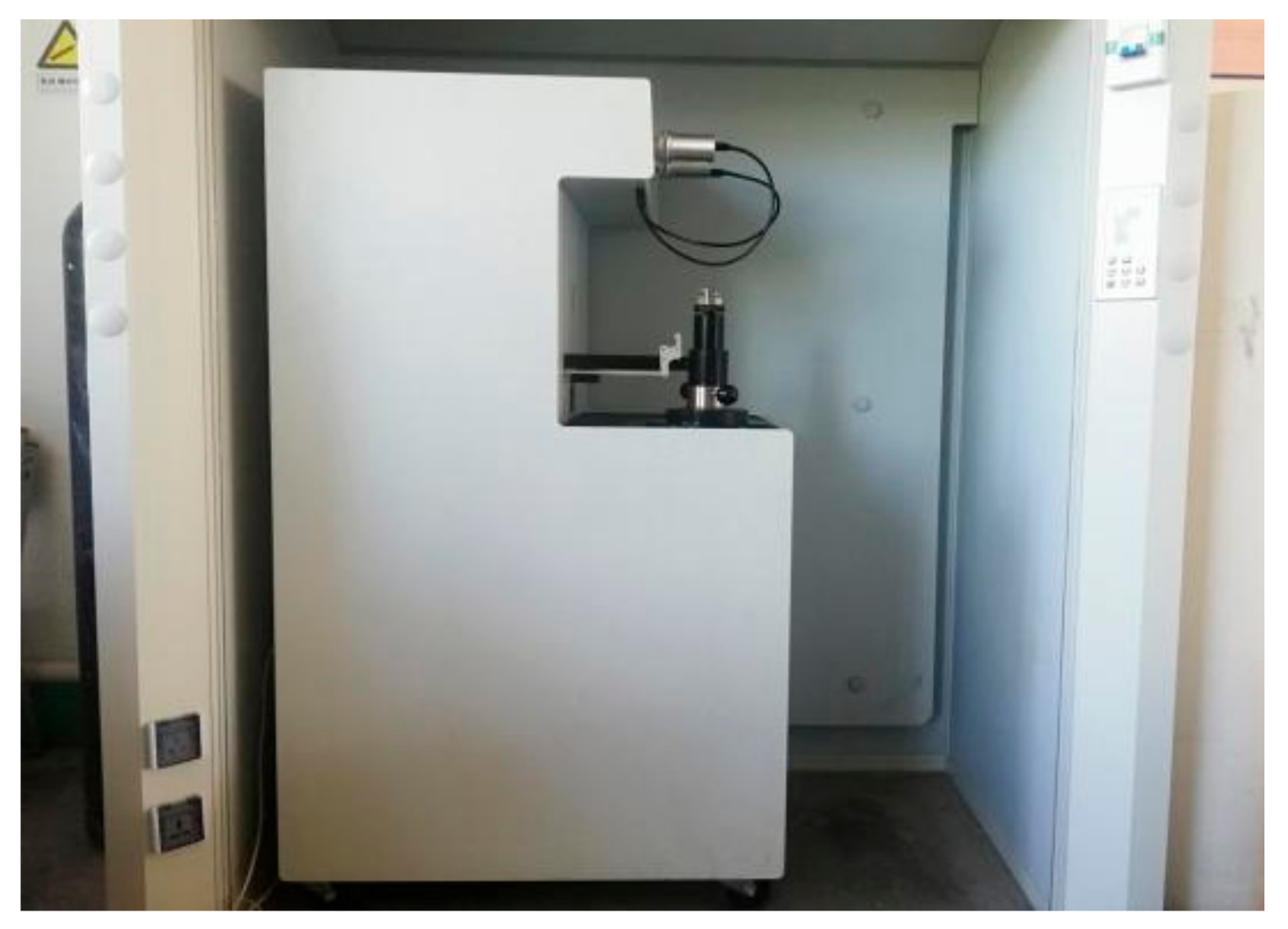


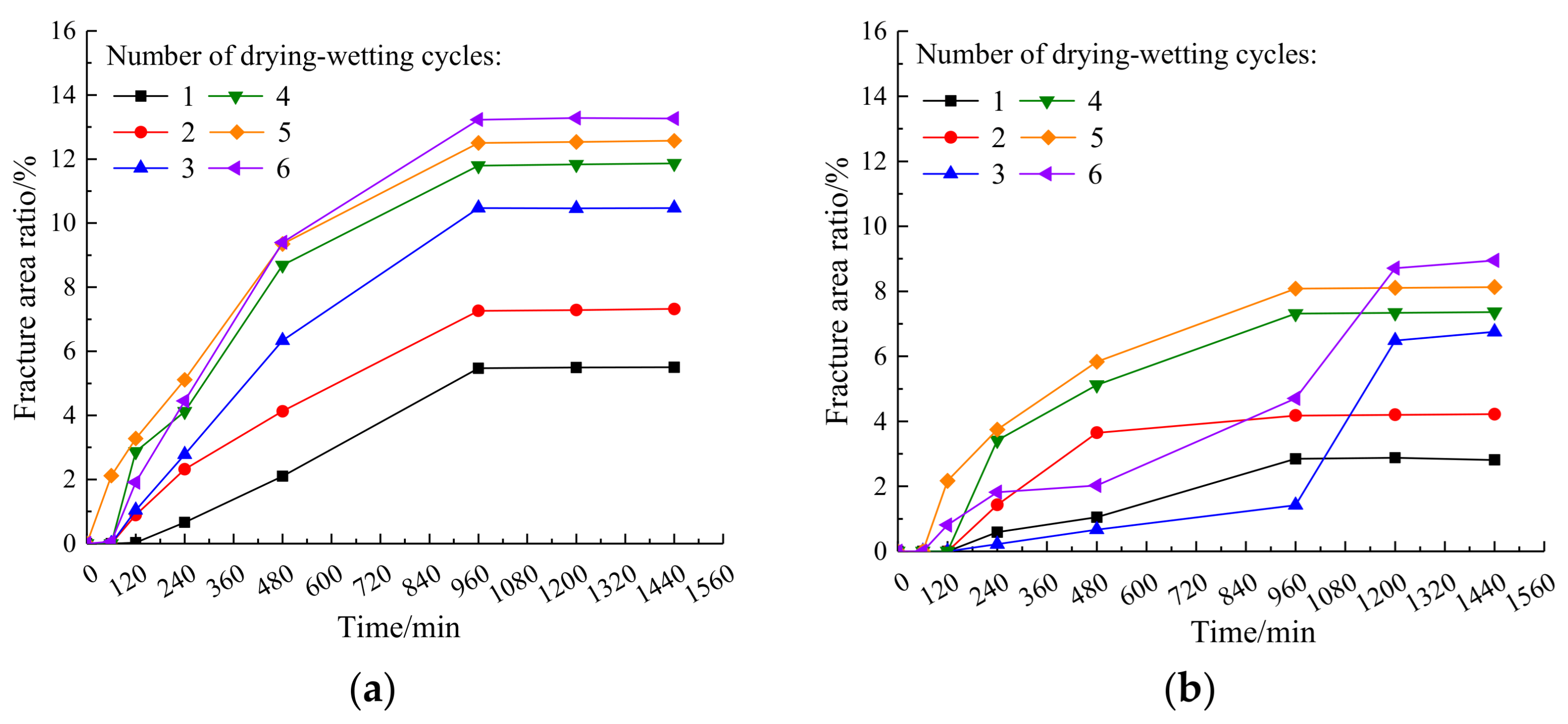

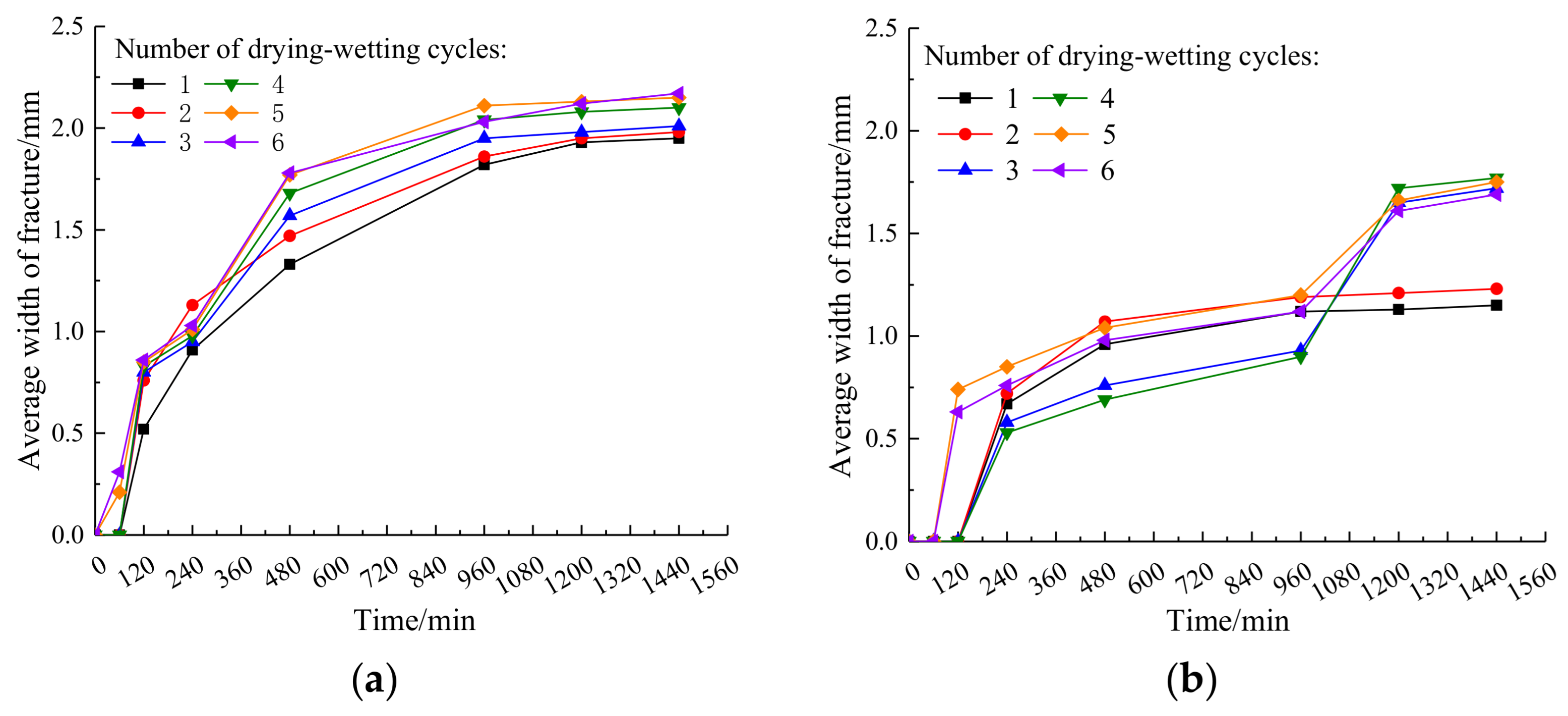
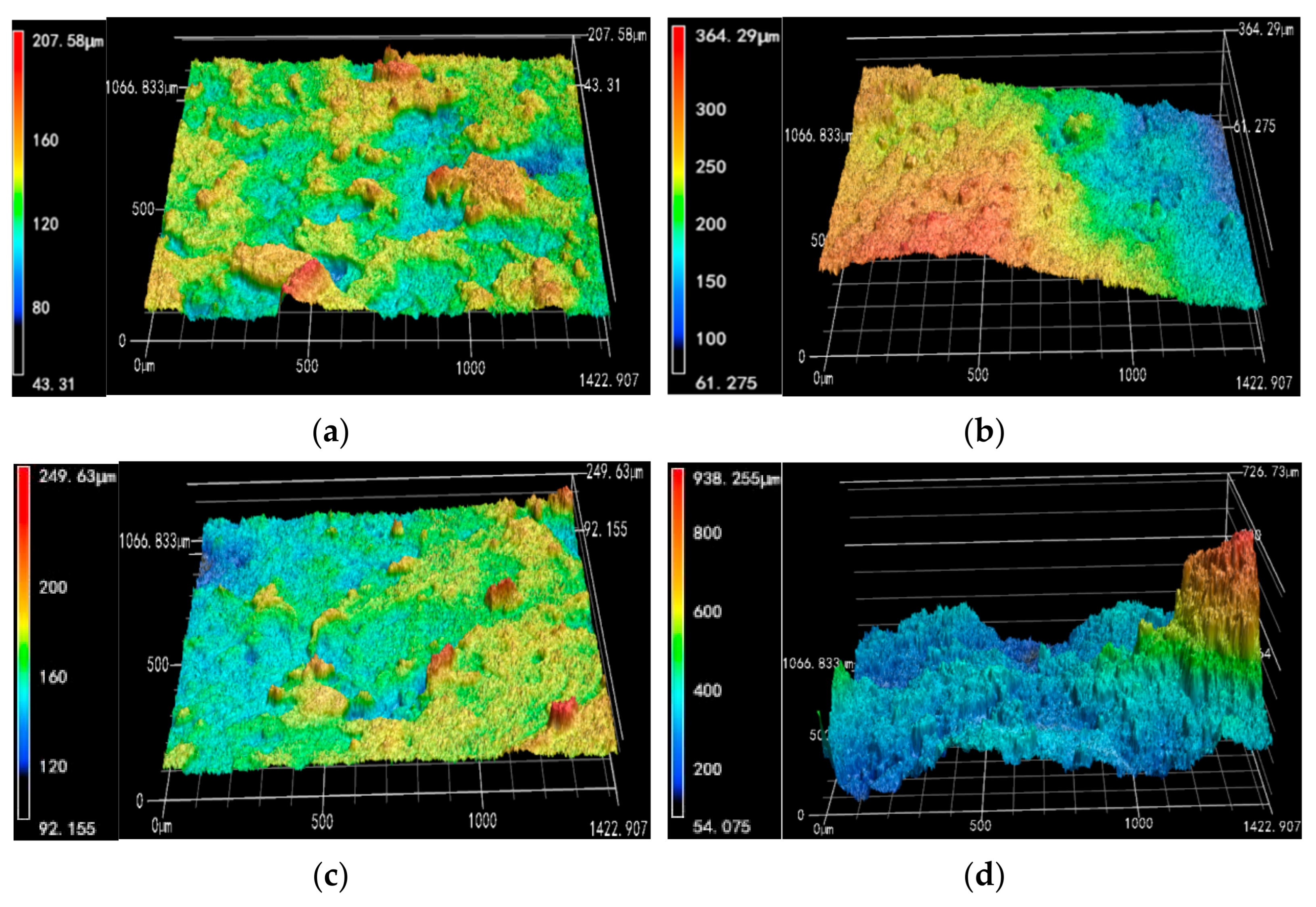
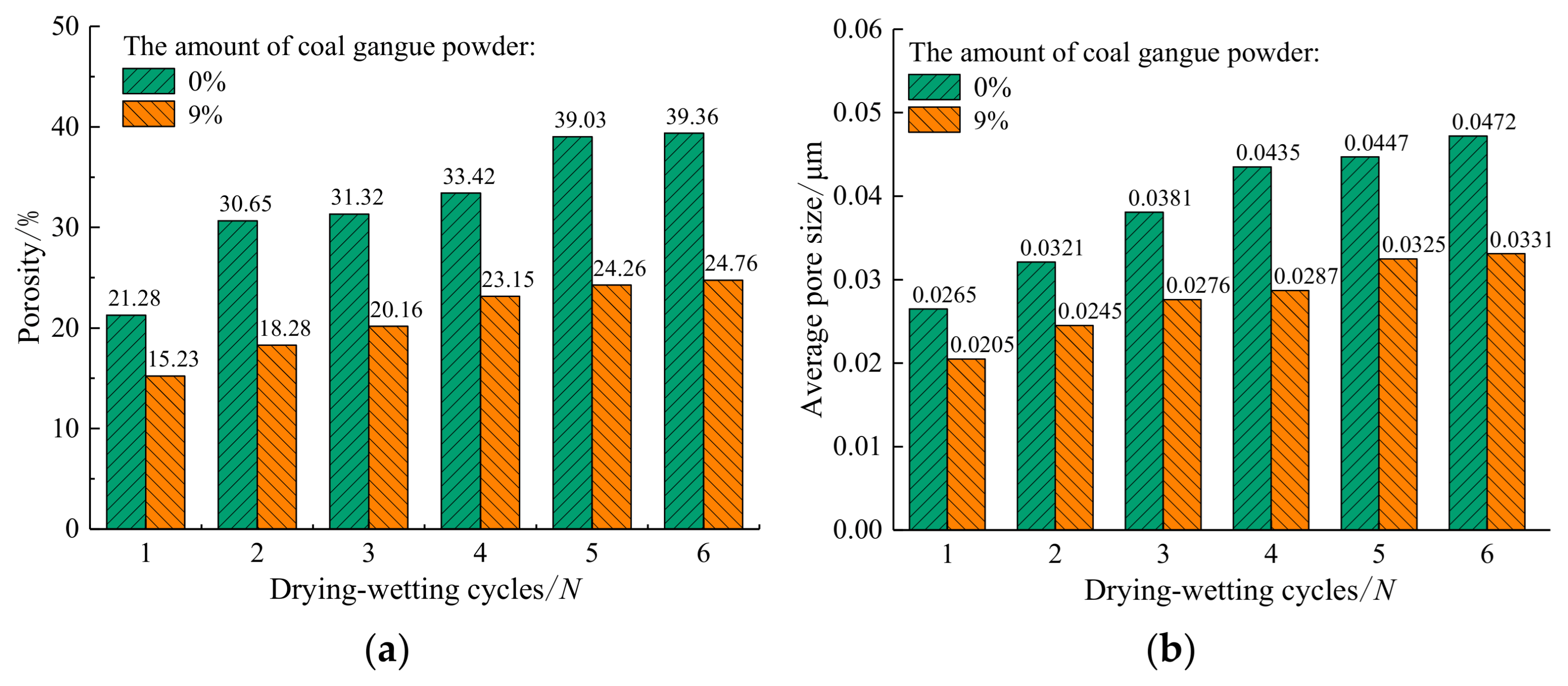



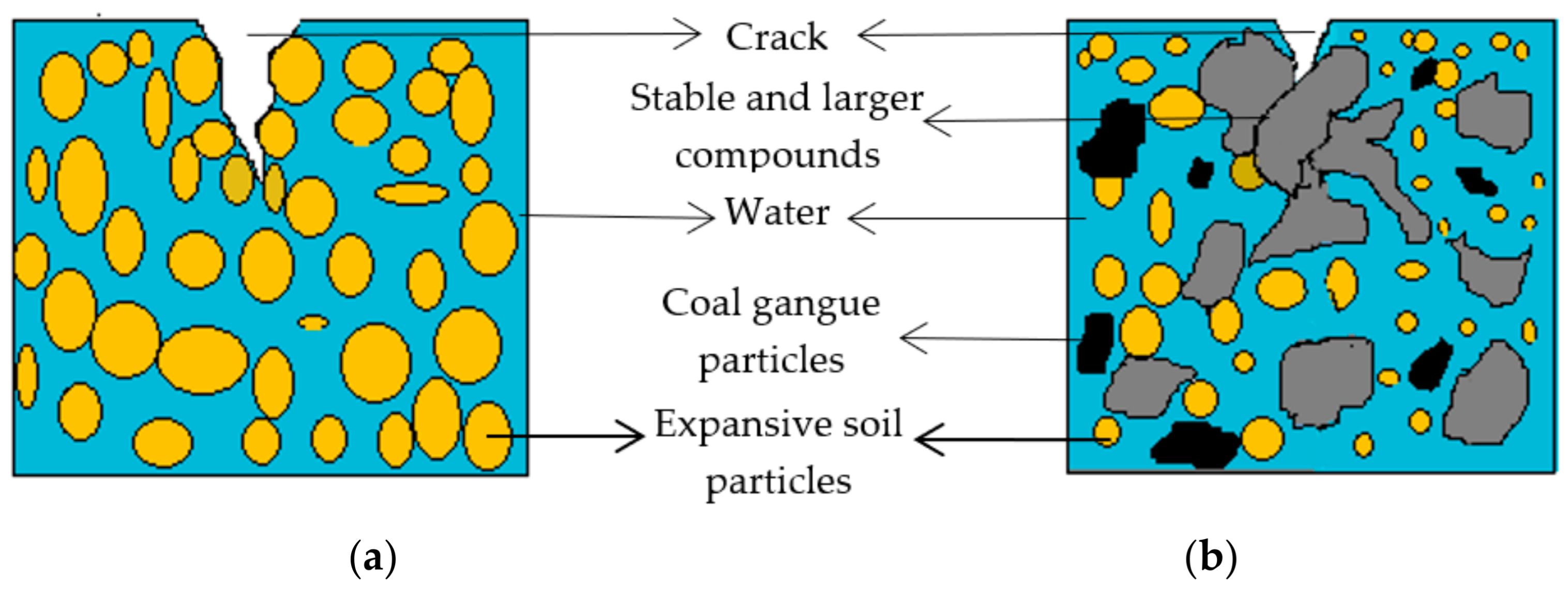
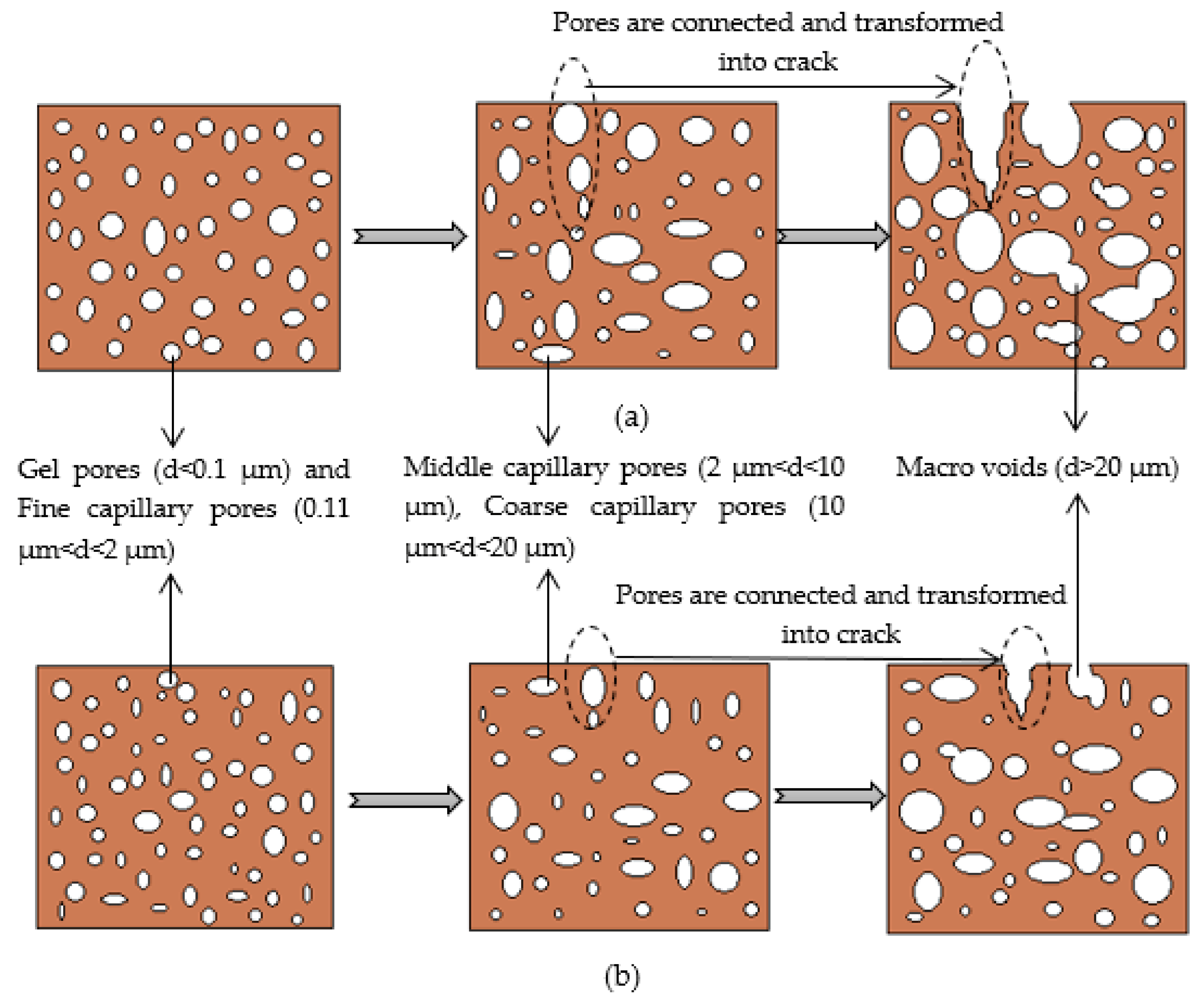
| Liquid Limit/% | Plastic Limit/% | Plasticity Index | Loss on Ignition Rate/% | Dry Density/(g·cm−3) | Free Expansion Rate/% |
|---|---|---|---|---|---|
| 52.3 | 27.7 | 24.6 | 13.5 | 1.61 | 49 |
| SiO2 | Al2O3 | Fe2O3 | MgO | CaO | Na2O | K2O | P2O5 |
|---|---|---|---|---|---|---|---|
| 64.3 | 13.34 | 2.63 | 2.76 | 0.88 | 1.73 | 0.88 | 0.06 |
| Free Expansion Rate/% | Water Absorption/% | Crushing Value/% | Non-Uniformity Coefficient | Curvature Coefficient | Loss on Ignition Rate/% |
|---|---|---|---|---|---|
| 13.7 | 0.7 | 20.5 | 3.4 | 2.2 | 14.2 |
| SiO2 | Al2O3 | Fe2O3 | CaO | MgO | C |
|---|---|---|---|---|---|
| 62.1 | 24.8 | 4.3 | 1.9 | 1.3 | 3 |
| Proportion of Coal Gangue Powder/% | Surface Roughness of Soil Sample/μm | Roughness of Soil Sample Crack Surface/μm |
|---|---|---|
| 0 | 13.69 | 48.91 |
| 9 | 14.36 | 95.45 |
| Parameter | Pearson Correlation | Sig. (2-Tailed) | N |
|---|---|---|---|
| Porosity | 1 | - | 6 |
| Crack area ratio | 0.910 * | 0.012 | 6 |
| Parameter | Pearson Correlation | Sig. (2-Tailed) | N |
|---|---|---|---|
| Porosity | 1 | - | 6 |
| Crack area ratio | 0.977 ** | 0.001 | 6 |
Publisher’s Note: MDPI stays neutral with regard to jurisdictional claims in published maps and institutional affiliations. |
© 2021 by the authors. Licensee MDPI, Basel, Switzerland. This article is an open access article distributed under the terms and conditions of the Creative Commons Attribution (CC BY) license (https://creativecommons.org/licenses/by/4.0/).
Share and Cite
Zhu, H.; Zhang, Y.; Li, Z.; Xue, X. Study on Crack Development and Micro-Pore Mechanism of Expansive Soil Improved by Coal Gangue under Drying–Wetting Cycles. Materials 2021, 14, 6546. https://doi.org/10.3390/ma14216546
Zhu H, Zhang Y, Li Z, Xue X. Study on Crack Development and Micro-Pore Mechanism of Expansive Soil Improved by Coal Gangue under Drying–Wetting Cycles. Materials. 2021; 14(21):6546. https://doi.org/10.3390/ma14216546
Chicago/Turabian StyleZhu, Hongxing, Yan Zhang, Zhuhan Li, and Xiaoyu Xue. 2021. "Study on Crack Development and Micro-Pore Mechanism of Expansive Soil Improved by Coal Gangue under Drying–Wetting Cycles" Materials 14, no. 21: 6546. https://doi.org/10.3390/ma14216546
APA StyleZhu, H., Zhang, Y., Li, Z., & Xue, X. (2021). Study on Crack Development and Micro-Pore Mechanism of Expansive Soil Improved by Coal Gangue under Drying–Wetting Cycles. Materials, 14(21), 6546. https://doi.org/10.3390/ma14216546






